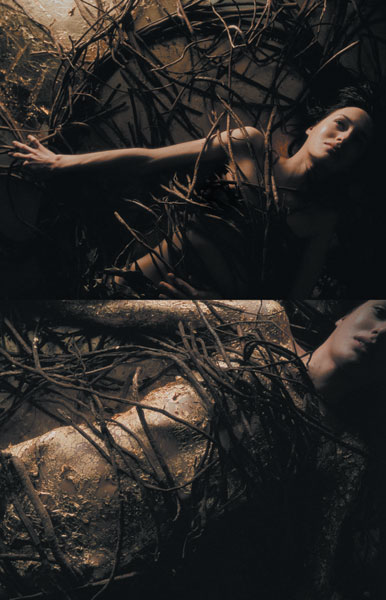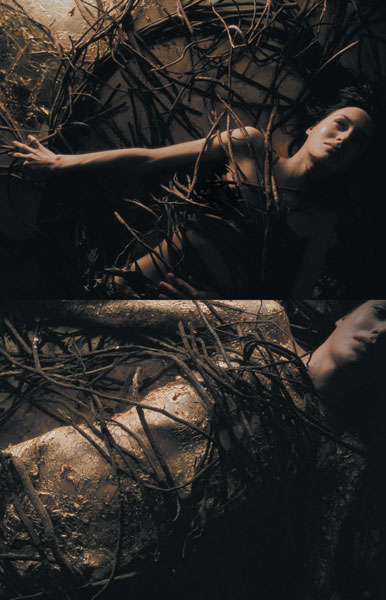When watching Edouard Lock’s work, one leaves the ordinary world behind.
There are no dishes to wash, no cellphones, no laundry no bills to pay except dues of the heart.
This otherworldliness can be disconcerting. Suddenly we have walked into a nineteenth century romantic poem. Only beauty and overwhelming sentiment.
The dancing in Amjad is exceptional. It is quick and lithe. Expressive and mysterious at the same time.
The lighting of Amjad is high contrast spots against an entirely darkened stage. Pools of light in shadows. Each dancer is clad in strict black, their costumes as elegant as if they came from a Dior Haute Couture collection. The astringent black and white costumes did recall in a curious way Marie Chouinard’s bODY_rEMIX from 2005 – credit in both cases to Vulcan who gave up fashion to serve dance instead.
We are seeing properly schooled dancers, with enormous natural talent, working at the peak of their abilities in original choreography. With La La Human Steps, we are a long, long way from the youngsters who have decided to stop taking class and boycott movement on the dance stages of Vienna and Paris. The road up Parnassus is long and hard – and Edouard Lock and La La Human Steps have made that long trek.
Amjad is what they have brought back for us.

A frames from the Amjad film (Lock and Turpin)
If one was wondering what it might be like to live in the time of Tchaikovsky and go to the ballet, while ballet was new and alive (not so much a collection of worldwide museum pieces like Swan Lake and Giselle and La Sylphide and Don Quixote) – La La Human Steps offer us that excitement. We are a long way from the brash iconoclasm of Lock’s early work like Human Sex (1985). The astringent choreographic language of Amjad respects the classic tradition which he is reworking here.
Quite wonderfully amid the relentless dance, Lock finds place for the musicians. Music and movement become one.
In Amjad, Lock is working with the music of Swan Lake and Sleeping Beauty as a starting point. The music has been reworked by three diverse composers Gavin Bryars, David Lang and Blake Hargreaves. They have each done remarkable work and the whole is collected under the the leadership of pianist and composer Njo Kong Kie. Tchaikovsky’s symphonic works are convincingly recast onto a piano, a cello (Elisabeth Giroux) and two violins (Jill van Gee and Jennifer Thiessen) with only the occasional support of ambient electronics.
This is typical of Lock’s work – he collects great individual talents to create a work greater than the sum of its parts. Part way through Amjad, Lock stops the dance to show us a film on three screens – to shoot the film Lock brought in award-winning cinematographer André Turpin, well known for the beauty and subtlety of his work in feature films like Maelstrom.
Pearl frames enclose what look like nineteenth century romantic paintings of first a woman bound in vines and then a man. The paintings rotate in their frames. Finally the woman’s left arm moves slowly. We are astonished. The iconography recalls famous canvases of the great European masters like Jan van Eyck with his treatment of light or even Caravaggio.
These short films last no more than about five minutes. But the production was treated with enormous seriousness. In addition to Turpin, Lock also had Johnny Ranger, Armand Vaillancourt, Louise Marie Beauchamps working on just on the creative aspects of these films. What could have been just a throwaway idea, was chiselled to perfection.
In the last ten years, Lock is not a prolific creator but a creator of perfect works. Amelia his last work came two years ago. Creation of a work like Amjad takes time.
On the other hand, throughout Amjad, Lock sails perilously close to romantic cliché. The underlying premise of his work seems to be straight from John Keats. "Truth is beauty and beauty is truth."
Alas, life is sometimes neither beautiful and the truth is nowhere to be found in beauty. But at the end, the technical mastery and Lock’s austere tastefulness triumph over romantic commonplace.
High points include a duet of dueling violinist each on a front corner of the stage while Keir Knight and Mistaya Hemingway fling one another through the emotional gamut of the music.
Bernard Martin is particularly expressive with his long locks. He seems like the lost poet, the lost romantic in the sea of mysterious and unattainable beauties. Early on he seems to seek the love of one of them, only to be abandoned. In subsequent scenes he dances with Andrea Boardman who seems to be dancing an androgynous role her costume not accenting any feminity and her dancing very muscular. Martin also dances a duet with Domonic Santia which suggests love is not restricted to the opposite sex.
Domonic Santia does some rather extraordinary dancing en pointe – normally pointe is reserved for women. This subtle breaking of the sex roles and tradition by putting a man on point is typical of the deconstructionist subversion of Lock’s Amjad.
The endless couplings of Amjad remind me of Arthur Schnitzler’s La Ronde. Every possible variation of pair is tried – even several trios where two men vie for the attention of a single woman or two women seek the affections of a single man. In the end, Amjad is an astonishingly decadent work of incredible technical perfection.
In Amjad and Amelia, Lock’s women represented the danseuse pure, an iconic image of feminine beauty dating back to the Muses. His women are pure, mysterious, unattainable and unspeakably beautiful. By now, I know that beauty that pure and devoid of corporeality does not exist on this earth but it does for ninety minutes on Lock’s stage in Amjad.
The penultimate scene is a duet to Swan Lake’s climactic scene transposed for chello solo and piano. Overhead huge white 3D balloons zoom towards us and explode loudly. Acoustic music, ambient sound, film effects and classical dance come together in a crescendo which send us wondering out into the night.
http://www.thestar.com/entertainment/article/213830 Interview with Edouard Lock about Amjad http://www.lalalahumansteps.com La La Human Steps website
Photo copyright La La Human Steps.


WE attended Amjad last night at UCLA. We have seen LLHS two or three times when they have come to LA or San Diego and they were one of our favorites. I so wish that I had your explanation of what was transpiring on stage. I would have had a totally different opinion of the performance. The complexity of the program demands some explanation. Unfortunately, there was not one word about the piece in the program – a first of the many, many of the dance performances I have attended over the last 30 years. Because of that, I had no idea of what was transpiring on the stage (apparantly about 1/3 of the audience didn’t either and exited in small groups after the first hour). As a result, my opinion was that the dancers were extraordinary – in technique, grace, and movement, but the continous repetition of the same movements was monotomous and boring. In addition, I had no idea of what the white balls were and how where they related to the dancers. I did recognize the music of Swan Lake and the dance of the dying swan at the end of the performance, but by that time it was too late! I think it was a disservice to the dancers that someone did not take the time or effort to write up a piece such as yours and include it in the program. My loss!